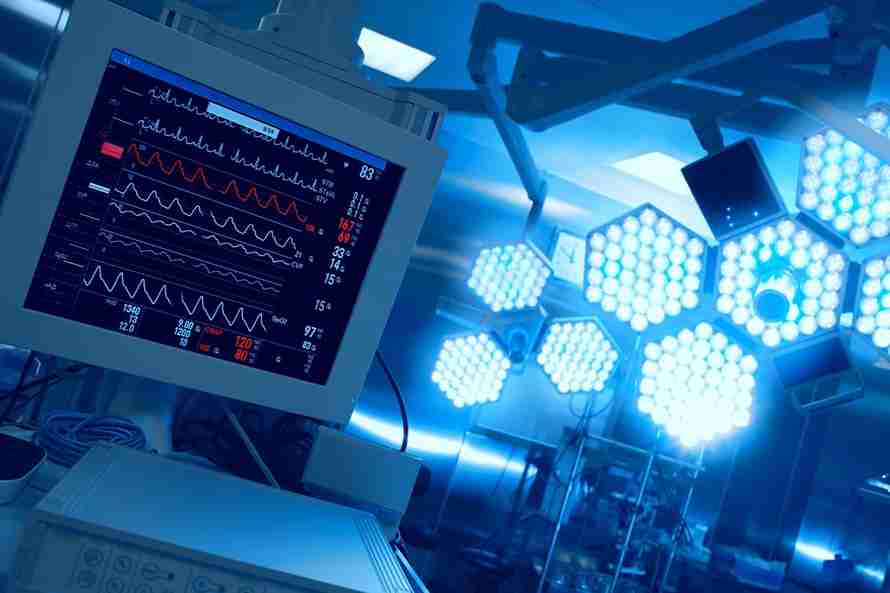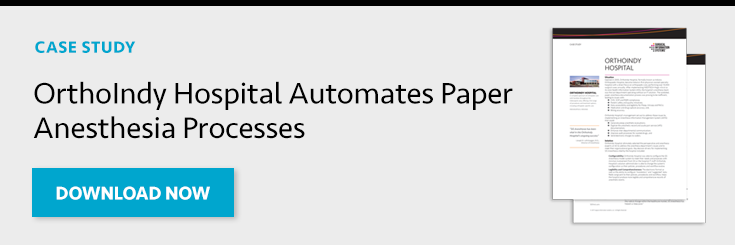 When organizations are determining their information management priorities, anesthesia software is often placed lower on the list. Reasons may include concerns about the difficulty in automating anesthesia documentation or other projects being deemed more important to an organization's performance. As a result, it's common to see many anesthesia providers still relying on paper documentation or using outdated systems.
When organizations are determining their information management priorities, anesthesia software is often placed lower on the list. Reasons may include concerns about the difficulty in automating anesthesia documentation or other projects being deemed more important to an organization's performance. As a result, it's common to see many anesthesia providers still relying on paper documentation or using outdated systems.
But the tides may be turning. Organizations are faced with increasing quality reporting requirements, meaningful use mandates concerning automated health record use, demand for greater data transparency, and a predicted shortage of anesthesiologists and certified registered nurse anesthetists. These pressures are pushing organizations to take a closer look at whether the addition or update of anesthesia software could support improvements in anesthesia provider productivity, compliance, and satisfaction, and avoid possible reimbursement penalties and patient safety risks.
Anesthesia Software Areas of Focus
When evaluating anesthesia software, consider including the following six qualities on your "must-have" list.
1. Ease of Use
Help achieve faster adoption of and engagement with new software by choosing a solution that's simple to operate and looks like the traditional anesthesia grid. An anesthesia provider should be able to perform essential software functions with little or no initial training. More advanced functions, even if their use requires training, should still be intuitive and support a logical anesthesia workflow.
In addition, the software should be designed to account for the varying responsibilities of today's anesthesia providers. While one typically associates anesthesia services with the surgical suite, providers also deliver services outside of the operating room. Some cases requiring anesthesia support may only take a few minutes. Software should allow anesthesia providers to complete their documentation requirements in a manner that allows them to efficiently move from case to case while accurately capturing anesthesia charges.
2. Quality Reporting Features
As noted, anesthesia providers are facing an increase in quality reporting requirements. In addition, many institutions are tying anesthesia pay to quality performance. Look for software that allows anesthesia providers to export data to help meet requirements, such as the Quality Payment Program's Merit-based Incentive Payment System (MIPS), and take advantage of benchmarking opportunities, such as those offered through the Anesthesia Quality Institute's National Anesthesia Clinical Outcomes Registry (NACOR) quality reporting. If a solution lacks reporting capability, additional time will likely be required to substantiate results.
Furthermore, a Kaiser Permanente study published in the Journal of the American Medical Informatics Association noted that using electronic health records to automate quality measure reporting reduced reporting time required for one measure set alone by about 50 percent. With such time savings, anesthesia providers can tackle other essential tasks.
3. Effective Integration
Take a moment to list the data points you need — or eventually expect to need — to document. Then, next to each point, note who you expect to document these details and where they should reside within a patient's medical record. The exercise should result in your identifying many items that will need to be included in various nursing records and the anesthesia record. To keep anesthesia providers from duplicating the nursing documentation, it's critical for any software you choose to include functionality that will allow for efficient integration with nursing records, scheduling systems, pharmacy systems, and billing systems.
The good news is that while the number of data points you must connect may seem overwhelming, interoperability requirements and choosing a partner that will provide integration support will help eliminate hurdles that can result in incomplete records.
4. Analytics Functionality
Staying informed about anesthesia performance is vital to achieving many objectives, including driving operational efficiencies, achieving quality outcomes, boosting revenue growth, and reducing waste. That's why there is a greater need for access to data and enhanced capabilities to analyze the information, which are achievable using analytics.
Unfortunately, solutions lacking such functionality may be able to only extract one-dimensional data or require so much time and resources (which can include the hiring or contracting of additional data analysts) that the information gleaned is outdated or so expensive that costs can overshadow the benefits or at least diminish their value.
Look for a vendor offering reporting features in a self-service business intelligence tool. This enables even an average user to run and display queries based on endless data selection variations. Such a platform can also allow incorporation of data from multiple systems. It is superior in its functionality compared to formats such as spreadsheets, PDF reports, and business objects.
5. Component in a Unified Perioperative Record
You can maximize the benefits of your anesthesia software investment by using it as part of a unified perioperative record provided by the software vendor. Consider that there are numerous overlapping points between the anesthesia record, nursing, scheduling, and other systems, as noted earlier. Such critical areas include medical history, allergies, and medications.
In addition, take into account the operational nature of surgery. Will the software remain synchronized (in near-real time) with case schedule changes? Will coding and billing staff be able to reconcile anesthesia charts against cases performed and not just those on the original schedule?
A unified perioperative record also supports efforts to standardize data across the entire patient record. Standardization supports consistency, which helps reduce errors and improves documentation completion time. Combined with the right analytics tool, a unified perioperative record can deliver far-reaching enhancements.
6. Strong Vendor Support
When weighing your anesthesia software options, it's imperative not to only research the solution itself. Perform your due diligence on software vendors and their approach to client service. A good vendor will provide support during training and implementation and continue doing so regularly to help you maximize the software's features and your investment in the process. The vendor should also continuously invest in research and development, delivering new functionality that will keep your software current and capable of meeting ever-changing requirements and needs.
Some topics to focus on when speaking with vendors include implementation timeline and flexibility to meet your organization's specific wants and needs, implementation methodology, training processes, support following implementation, and frequency of new functionality releases.
Choosing Anesthesia Software: Closing Thoughts
Researching options for software — and its vendor in the process — is an exercise not to be taken lightly. Hopefully the solution you choose will effectively serve your anesthesia providers for many years and will receive ample support and updates/expansions from your vendor partner (the company should be a partner and not just a seller).
While getting buy-in from all anesthesia providers for adding new software or significantly upgrading an existing system can prove difficult, selecting a solution that is easy to use, fits in naturally with anesthesia's existing workflow, and improves productivity should help convince even the more ardent naysayers to at least have an open mind about the technology. Make sure the software you choose can interface with other systems and will help you meet regulatory standards and maintain compliance. Finally, invest in a system that provides the ability to analyze and scrutinize the massive amounts of data you will collect in ways that generate meaningful results and can help drive short- and long-term improvements.



























